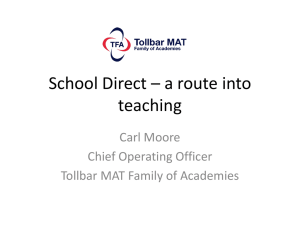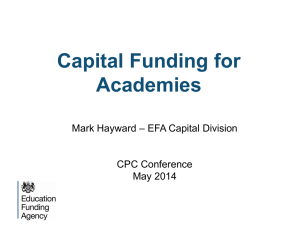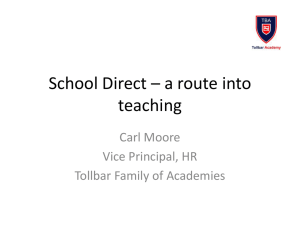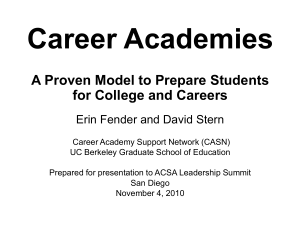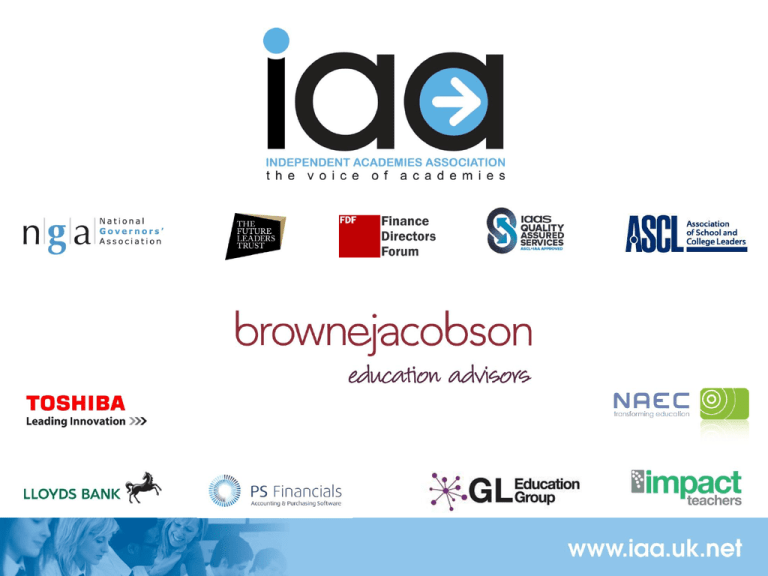
Strand 3: Great Financial Leadership
Optimising your resources
Strategic financial planning and
accountability – costing your curriculum
Val Andrew, ASCL Business Management
Specialist
Sam Ellis, ASCL Funding Specialist
The process for internal audit and how it adds value
Stephanie Mason, Head of Academies, Further Education
and Skills, Baker Tilly UK Audit LLP
Alan Evans, Finance Director and Company Secretary, CWA
Academy Trust
Internal Audit – Adding ValueMarch 2014
www.bakertilly.co.uk
Agenda
• Introductions
• Academy Assurance Requirements
• Board Assurance Framework
• Assurance Mapping
• How does it work in practice?
6
Introductions
• Stephanie Mason – Head of Academies, Further Education and
Skills, Baker Tilly UK Audit LLP
• Alan Evans – Finance Director and Company Secretary, CWA
Academy Trust
7
Academy Assurance Requirements
• Academies Financial Handbook
•
Every Academy Trust must have in place a process for independent
checking of financial controls, systems, transactions and risks
• Accounts Direction
•
Governance Statement
•
•
As trustees we acknowledge we have overall responsibility for ensuring
that ABC Academy Trust has an effective and appropriate system of
control, financial and otherwise
Compliance Statement
•
As Accounting Officer of ABC Academy Trust I have considered my
responsibility to notify the academy trust board of trustees and the EFA of
material irregularity, impropriety and non compliance with EFA terms and
conditions of funding under the funding agreement in place between the
academy trust and the Secretary of State.
8
Kings Science Academy free school
founder arrested over alleged fraud
THE FOUNDER AND PRINCIPAL OF A FLAGSHIP FREE SCHOOL PRAISED
BY DAVID CAMERON HAS BEEN ARRESTED BY POLICE INVESTIGATING
AN ALLEGED FRAUD.
9
Richard Gilliland Lincoln Priory
Academy probe findings handed to
CPS
Lincolnshire Police has handed a file to the Crown Prosecution Service
after a 20-month investigation into the financial scandal surrounding
Lincoln’s Priory Federation of Academies.
Richard Gilliland, the £206,000-a-year chief executive who quit the
federation on March 30, 2012, employed his wife, daughter and son in wellpaid jobs, which included some expenses for a fact-finding mission to Bali.
He used a school credit card to buy sex games and Christmas dinners and
10
school funds to pay for his son’s training at an equestrian centre.
The Telegraph
Academies paying millions to businesses
linked to their directors
Taxpayer-funded Academy chains have paid millions of pounds to businesses with
personal links to their directors and trustees, it has been revealed.
The payments – including for consultancy fees, IT advice and legal services – have
led to fears that the Department of Education is not monitoring the books closely
enough.
There is no suggestion that the nine trusts involved or their directors have broken
any rules, and they all maintain that they have been properly audited.
11
Board Assurance Framework
What is a board assurance framework?
A structure within which the Academy identifies the principle risks of not
delivering on its vision and values and not achieving its strategic goals;
establishes the systems and controls necessary to manage and mitigate those
risks; and receives adequate assurances about the effectiveness of those
systems and controls
What is meant by ‘assurance’?
Assurance Definition
Provides:
Confidence / Evidence / Certainty
To:
Managers / Head Teacher (as Accounting Officer ) / Governors
That:
That which needs to be done (operationally and strategically) is
being done
12
Assurance Mapping
What is an assurance map?
An assurance map (AMAP) is a tool to ensure assurance of controls over key
risks within the organisation. The assurance mapping process drives out gaps
and overlaps in the overall assurance jigsaw.
13
Why is it useful to academies?
• Increases understanding of sources of assurance
• Management accounts
• Risk management reports
• Performance management reports
• Ofsted
• External Audit
• Internal Audit
• EFA
• Clear, matrix based
• Shows gaps and overlaps
• Compliance with Academies Financial Handbook
• Programme of independent checks of financial controls, systems,
transactions and risks
14
How does it work in practice?
Principle
objectives
Key risks
Key
controls
Assurances
Evaluation
Action plan
15
‘Three lines of defence’
1st
2nd
3rd
• Departmental level – operational managers and staff
• Day to day responsibility for managing and controlling risk
• Implementation and compliance with polices and procedures
• Corporate Governance Framework – Governing Body and subcommittees
• Monitoring of outcomes from the first line of defence
• Independent review – overall compliance and risk management
• Regulators (EFA), OFSTED, External Audit, Internal Audit, Other
3rd parties
16
For example
Risk Assessment
Sources of Assurance
1. Management Operations
Example risk areas
Gross
Net
Reporting
2. Governance Oversight
Risk
Self
Governing
Management Assessment
Body
Finance
committee
3. Independent Assurances
EFA
OFSTED
External
Audit
Internal
Audit
17
Common pitfalls
• Risk register
• Incomplete or not up to date
• Only shows net risk scores
• Independent assurance
• Not fully understood
• Frequency of review?
• Depth and detail of review?
18
End result …
Focussed, value added internal audit plan:
Review Area
Rationale
Core Financial
Areas
To ensure that key processes and procedures are
operating efficiently and effectively throughout the period
under review
Corporate
Governance
To ensure that appropriate procedures are in place in
relation to Corporate Governance, for example:
• Governor Training
• Conflicts of interest
• Gifts and Hospitality
Risk Management
To ensure that risk management procedures are
sufficient to identify all key risks to which the Academy
Trust is exposed, to assess the impact and likelihood of
those risks arising and to implement action plans to
address risks identified
19
Internal Audit
• CWA Academy Trust
• Sponsored by local FE College
• Based in West Norfolk
• Area of low education aspiration
• First academy in 2010
• Became MAT July 2013
• Taking on four further academies 2013 – 2014
20
• Trust Ethos
• Allow academies to retain local ‘feel’
• Support services Finance and HR managed at Trust level
• Highly professional Board of Directors – adopted strategic approach
• Always wished to demonstrate high standards of governance
21
• Internal Audit 2010
• RO governor option
• Reciprocal arrangement
• Retaining Local Authority audit
• Preferred choice was to use internal auditors in RO role
22
• Rationale
• Wanted the external assurance
• Professional credibility
• Wanted more than simply the RO functions
• Integral part of internal control framework
• Looking ahead
23
• Impressions – does it add value?
• There are cheaper options
• Audit work has been of a consistently high quality
• Clear understanding of academies governance
• Reports to Board of Directors well presented – Audit Manager present
• Risk Management workshop particularly successful and achieved buy in
from Directors
• Risk management workshop being re-run
• Conclusion of Board to retain current arrangements
24
• The Future
• Currently developing audit plan
• Focus will be on ensuring internal controls in all academies
• Dialogue to ensure relationship between Sponsors / trust are clear
25
Reviewing and improving your procurement
practices
Steve Archer, Team Leader, Schools Commercial
Team, Department for Education
Will Jordan, Education Sector Manager, PS
Financials Limited
Improving your
procurement and achieving
value for money
Steve Archer
Schools Commercial Team
Commercial Division
How can improved procurement help
you….
save money
get better
value for
money
be
accountable
for what you
spend
follow the
law
Public Sector Procurement –
what does it mean for Academies
EU Procurement Directives – Financial
Thresholds
From 1st January 2014
EU Procurement Directives and
The Public Contracts Regulations 2006
For Schools & Local Authorities thresholds
are:• £172,514 Goods & Services (£111,676
for DfE)
• £4,332,012 Works (i.e. Buildings)
Regulations do not apply in full when the
estimated value of contract is below
threshold
but Treaty principles do
New EC Procurement Directives
Revised directives agreed by
EC June 2013. Anticipated to be
UK law by August 2014.
Changes to UK public sector
procurement regulations will
be highlighted to schools in
BuyWays this summer
The
current
climate
Importance of efficiency and
financial management
What can you do?
• Analyse expenditure
• Review your contracts
• Identify opportunities for rationalisation
• Deliver admin savings
• Collaborate across key strategic spend areas
• Benchmark and compare
Collaborate?
• What have we
found?
• Top tips
• Key considerations
3 primary Academies located
within 6 miles of each other.
“Now we can negotiate outside
of the constraints of the LA and
work to get better services,
based on what we know works
for our schools. The bar has
been raised and prices are
much more competitive”.
We’ve taken the work out of finding
good deals in key spend areas…
Energy efficiency projects
What the project aims to
achieve:
• To increase energy
efficiency within schools
• Deliver long term energy
savings
• ACMF – heating
replacement programme
announced by EFA
through
Schools ICT
• Schools ICT Services Framework
– expires Oct 2014
• Information Management &
Learning Services (IMLS)
Framework – expires March 2016
• Microsoft MoU for UK Schools
Don’t be headline news…
• Crown
Commercial
Service framework
• 3,600 schools
• £11m spend and
case studies
evidencing 49%
savings.
Build your procurement skills…
www.buyways.co.uk
Academies Zone
Useful links
Procurement deals and information
www.education.gov.uk/procurement
Effective buying for your school Publications - GOV.UK
Academy Procurement Resource
www.education.gov.uk/schools/leaders
hip/typesofschools/academies/open
stephen.archer@education.gsi.gov.uk
Sweating your assets/making the most of and
developing your buildings and facilities
Julia Green, Solicitor, Browne Jacobson
Keith German, Director, AA Projects
Getting the most from your assets ……
Julia Green – Partner Browne Jacobson
Facts and figures….
• What do you predominantly use your
site for?
• What do you do with it for the rest
of the time?
The first steps ………..
• Why would you look to generate
income?
• What is your strength?
IAA Spring National
Conference
'Sweating your assets: Making
the most of and developing
your buildings and facilities'?
Do you know what you have got?
•
•
•
•
A familiar Picture
Due diligence
Liabilities and responsibilities
What is the future?
How can the future be delivered?
Basic Need
Salix – Energy
Conservation
DSG
Local sources and
fund raising
Academies Capital
Maintenance Fund
Sport England
ACMF
•
•
•
•
•
•
What is it for?
£442m across two funding rounds
R1 - 3000 applications from 2000 Academies
200 applications
Regular liaison
Exchange
What do Academies need?
• Understanding
• Capital
• Reduced running costs
• Maximise income
• A strategic action plan
Is there a better approach
Determining whether or not to apply
• Understanding the key building issues on your site
• and your legal responsibilities as an academy
• Understanding the criteria for the programme
Preparing the bid
• Securing up to date information
Preparing to deliver the project
• Putting the right team and governance in place
Solid Evidence Base
Clear Priorities
Strategic Estate Planning
Why?
– Support and deliver the school’s vision
– Understand (and manage) legal responsibilities
– More cost effective than crisis management
– Good governance
Why not?
– Too difficult
– Perception that requires costly consultant support
– Other priorities
Is there a solution?
•
•
•
•
•
•
Up to date condition survey
Asbestos survey
Statutory compliance
Planned maintenance programme
Facilities Management?
Property Strategy and Masterplan
–
–
–
–
–
–
5 year plan to address condition
Growth strategy
Coherent masterplan
Financial strategy for delivery
Support for funding
Demonstration of commitment
Case Studies
Secondary Academy – 11-18
Midlands
Issues
Site constraints
Successful
Oversubscribed
Dilapidated buildings
Backlog maintenance
Strategic goals
Expansion
Fit-for-purpose facilities
AA Projects have worked with this Academy for two and a half years, and have secured
funding for an 8 classroom extension to provide additional capacity. This was the first phase of
a 5 year plan to increase capacity and address major condition issues.
The Academy have an up to date condition survey which replaces the previous LA survey.
They have a new planned maintenance programme. They have a 5-year plan and the recent
application to the EFA for ACMF funding is the next identified priority, which is another
significant new-build at around £3m, which stands a good chance of being approved.
Strand 3: Great Financial Leadership
Optimising your resources
Reputation and Revenue
Dean Blake, Communications Manager Cabot
Learning Federation.
Mat Harnan, Trust Leader: Communications and
Development, Torch Academy Gateway Trust
Welcome
Overview
Retention
and
Recruitment
Student numbers and the type of students your school attracts have a decisive impact on
financial budgets and educational outcomes.
For a school to be viable and sustainable it must ensure consistent or
In
an educational
environment
driven by market forces, schools can no longer rely on
increasing
student
numbers.
pupils being supplied by ‘catchment’ primary schools.
Recruitment
and retention
of student numbers
depends
a range
of
Parents are increasingly
making well-researched
and considered
choiceson
about
the
school
they
choose
to send their
to.
factors
that
ultimately
formchildren
a reputational
opinion of the school held
by pupils, parents, the local community and the wider educational
These choices are only as considered as the information parents have access to.
establishment.
Therefore, the more a school takes control and ownership of its reputation, the more
positive
the message
parents receive.
To manage
this reputation,
investment in three areas of marketing
can
have a significant medium and long-term impact on the reputation of a
school.
Wider
Reputational
Profile
Student
Recruitment
And
Retention
Stakeholder
Engagement
Managing
Reputational
Risk
Wider Reputational Profile
Direct engagement with future school users
•
•
•
•
KS2 English and Maths Support
Creative Arts
Sports coaching
Student Ambassadors
Direct engagement with local community
•
•
•
Student and school involvement in local council
Events to bring community into school
Students working in local community projects
Direct engagement with wider educational community
•
•
•
Involvement in collegiate development projects
Partnership working with other schools
Local, regional, national and international exchanges
Stakeholder Engagement
Improved direct engagement with parents
•
•
•
•
•
High quality and professional print materials
High standards of telephone and reception engagement
Consistent and professional teacher-parent communication
Regular dissemination of information and events
High quality newsletter/annual
Direct engagement with students
•
•
•
•
Student council
Strong focus on student wellbeing
Internal promotion of extra-curricular opportunities
Student magazines/newspapers/radio stations
Direct engagement with other stakeholders
•
•
Ensuring stakeholders are kept informed of work in the school
Inviting stakeholders in to experience life in the school
Managing Reputational Risk
In School
•
•
•
Managing complaints in a consistent and effective manner
Proactive dissemination of preventative information
Clear guidelines on staff conduct
Press Contact
•
•
•
•
•
Good press relations
Proactive responses to local or national stories
Clear hierarchy of responsibility in the event of a press contact
Contingency for negative press contact
Training for staff involved in press contact
Knowing what is coming
•
•
Anticipating possible media scrutiny
Offering alternative or counter-intuitive stories to trending issue
Funding - a forward look
Mike Pettifer, Director of Funding for
Academies, Education Funding Agency
Funding
A Forward Look…
Mike Pettifer
Deputy Director
Academies Funding Division
EFA
Introduced a Stage
Gate Process for
project and
programme delivery
In brief I will be talking about…
• What we have done already in funding
• How the sector is consulted and involved in developing policy
• Governance framework for working with academies and free
schools
• Move to more contemporary funding agreements
• Emerging views on VFM statements
• Post 16 Funding
• Working with customers in the future
What we have done already in funding
New approach to communications
Webinar
Webinar
Filmed
Slide packs
participants views (after
presentations downloaded
(on the day) the event)
Pre-16 Funding
Pre-16 Funding Update
High needs for LA
High needs for Academies
Introduction
Sixth Form Funding
Sixth Form Funding Update
Free Schools/UTC/Studio School
Total
Last updated 25 Feb
1415
2923
676
636
427
2478
8555
1629
4056
665
780
1635
3172
11937
• 2014/15 – over 25,000 downloads and viewings
• 2013/14 - 32 briefings covering about 1300 academies
158
308
-
1639
1601
132
598
824
4064
Our service is improving but needs to
continue to do so
Governance Structure & Consultation
Funding & Finance
• Formal consultation on large scale reform
- e.g. 2013 funding reform, post 16 simplifications, etc.
• Formal governance structure for feedback/communication/consultation
- EFA Advisory Board (All EFA business)
- EFA/SFA Advisory Forum (Post 16 focus)
- Technical Advisory Group (Post 16 focus)
- School & Academy Funding Group (pre & post 16)
- Academies Finance and Assurance Group (pre and post 16)
• Informal customer feedback/networks/representative bodies
- informal consultation ASCL, FASNA, SSAT, IAA, NABSM (pre & post 16)
- customer focus groups – (pre 16) e.g. funding statement, funding guidance,
pre & post 16 split, payment profiles, PNA, free schools, High Needs providers
Move to contemporary funding
agreements
• Negotiations with existing trusts and sponsors
• New simpler and clearer language
• Consistency balanced with flexibility
• Plain English
• More robust dialogue on estimated pupil numbers
Emerging views on VFM statements in
context of wider financial duties
• Accounting Officer is personally accountable both to the Secretary
of State and Parliament for the propriety and regularity with which
public money is used
• A requirement to produce company accounts every year and have
them independently audited and published
• The trust’s Accounting Officer is required to account for the use of
public funds through an annually published Value for Money
statement
• An independent auditor’s annual ‘regularity report’ about the proper
use of funds, also published
• Trusts face sanctions when things go wrong under robust
intervention arrangements set out in the financial handbook
Post 16 update
• Letter from Peter Mucklow in December setting out the overall approach and
timeline, along with any policy changes, included a reduction in funding for
18 year old on full-time programmes
• Student number statements have been sent out to academies to check
headline figures (Jan/Feb)
• Any cases for changes following those statements are currently being
reviewed (Feb/Mar)
• Final decisions by ministers on the rate expected in the first part of March
• Final funding statements including post 16 funding will be sent out by the
end of March
Post 16 - continued
There are a lot of detailed issues which FDs will need to understand re data
capture which will affect funding, for example:
• Need to put planned hours for academic year 2013/14 in the 2014/15
autumn census as well the planned hours for academic year 2014/15
• Need for students in sixth form without either Maths or English at GCSE
Grade C to be enrolled on maths or English otherwise the school will
lose funding the next year
• Work experience can only be recorded as such if it is with an external
employer – otherwise it has to be recorded as non qualification activity
It is really important for FDs and other MI/data literate staff to access
the film and webinars.
Working with YOU into the future
Customer Exchange – Key Principles
• Customer Exchange will
transform the way both you
Introduced
number
and
we doaour
business
of new governance
boards to ensure
strong internal
• For the
first time we will also
governance
be
able to bring
all of our
(Programme
Delivery
CAB)
dataBoard,
and financial
information together in one
place. This will make it easier
for you and us to access and
interact in one digital view, at
a time that suits
Why now?
NAO Report
Need for More
Efficiency
Reduce administration
Introduced
a number
costs
of new governance
boards to ensure
strong internal
governance
(Programme Delivery
Board, CAB)
The Agency is
implementing plans to
allow customers to do
more for themselves.
Accelerated Transformation
Dealing with
Increased Demand
50% increase to
12,000 institutions
over 3 years
Need for Greater
Accuracy
Maintain accuracy
whilst significantly
increasing
transactions
Introduced
a Stage
Gate Process for
project and
programme delivery
Enhanced IT
Delivery Capability
Need for Better
Customer Service
Investing in IT and
People Expertise but
using models that are
tried and tested
Need to improve
feedback and levels of
satisfaction from our
customers
Customer Exchange – The benefits
Benefits for our customers
Business
Planning
Calendar
Knowledge
Base
Digital by
Default
1. Online web base access to EFA information
and submissions
2. One sign in password to access all
information relevant to the EFA, through DfE
Secure Access portal.
3. Ability to reset own password
4. Collections will be digitised with on line
forms
5. Online planner clearly showing what
information and actions are required by
day/month or task
6. Knowledge base to allow providers to search
for the information they require
7. Ability to be able to update their own key
contact details
8. One stop shop for EFA and DfE news
9. Links to other relevant websites such as DfE
and .gov.co.uk
Digital
Collection
Forms
Document
Exchange
Portal
Online
Collections
In Summary…
“Looking outwards not upwards.”
• You are seizing the challenge of innovation with responsibility
• You are seizing the challenge of driving up standards with accountability
• We are demonstrably getting better at what we do year on year
• We are listening to you and trying to make our approach centre around
you as often as possible
• We are ALL becoming more efficient and continually offering better value
for money for the tax payer
ARE WE MOVING QUICKLY ENOUGH AND GETTING IT RIGHT OFTEN
ENOUGH FOR YOU?
The FDs perspective: a short response from the FDs
Forum
Chris Hutton, Director of Finance, City of London Academy
Jim Cook, Deputy Principal Finance and Resources, The
Samworth Enterprise Academy
Great Financial Leadership:
Surgery Q & A panel
Facilitated by Gareth Dawkins, Executive
Principal, Bradford Academy and IAA Vice
Chair

